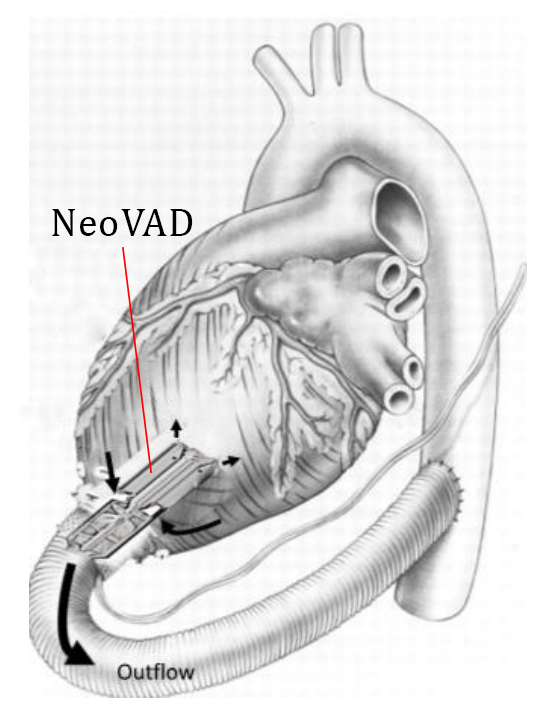A long term, fully implantable Ventricular Assist Device designed specifically for paediatric patients. It’s purpose was to completely unload the Left Ventricle of the patient.
The design is derived from an Intra-Atrial Pump (IAP) which partially unloaded the LV of an adult 23. IAPs are implanted between the left and right atrium, making them minimally invasive, and a promising design for miniature heart pumps.
 The NeoVAD implant location (24)
The NeoVAD implant location (24)
Most of the blood passes through the primary Impeller and Diffuser of the NeoVAD to the outlet, with a small amount passing through a washout impeller which helps prevent thrombosis and blood stasis.
The NeoVAD uses a magnetic levitation (MagLev) system coupled with permanent magnet (PM) rings to control the radial position of the rotor. This removes the risk of mechanical wear that may occur in the device. A coil/back iron is used for active axial control.
 A cross-sectional view of the NeoVAD (24)
A cross-sectional view of the NeoVAD (24)
The pump will operate at a target Flow Rate of 100mL/min/kg. This results in three key operating conditions for patients weighing 5, 10, and 20kg. These clinical requirements must be met for the pump to match the physiological conditions of the patient and to successfully perform the LV functions.
The pump features a Washout Impeller to reduce the amount of time the red blood cells experience high Shear Stress. If the stress is too high, red blood cells may rupture (Haemolysis).
The impeller was designed to be sensitive to Afterload, even at a constant rotational speed. This means that a lower flow rate will be generated where there is a high-pressure gradient (in Diastole), and conversely, a higher flow rate can be generated against a low-pressure gradient (in Systole). Consequently, there would be no requirement to actively control the speed of the pump during the Cardiac Cycle.